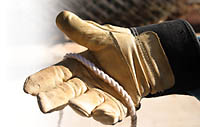
Don’t you hate to wear gloves? I know I do. When cold weather comes I put my gloves in my coat pocket, but unless it’s awfully cold I never use them. I think it is because even the best gloves seem bulky. Did you ever try to switch a car radio station while wearing gloves? It doesn’t work too well.
I do have to admit that I wear work gloves when I do yard work, but that’s only because I have had so many blisters and cuts in the past that I have learned my lesson.
With this being said, I also have to admit that wearing protective gloves helps reduce injuries in any industry where employees’ hands are at risk. This covers most jobs from the assembly line worker to the lab technician.
Put gloves to the test
Before looking for the best glove for the job, review the task and make sure that the hazard can’t be corrected so that gloves won’t be needed. For example, a machine operator may be wearing gloves because the edges of the machine are sharp. Instead of issuing gloves, maybe the sharp edges could be rounded.Once you determine that gloves are, in fact, needed, have a glove distributor come to your workplace and offer a glove evaluation. The distributor will look at the work being performed and recommend gloves most suited to those tasks. Have more than one distributor visit to get a good overview of all gloves available on the market.
After the evaluation, choose the type of gloves you would like to try out. The distributor will usually provide gloves for you to test at no charge.
Keep in mind that gloves are used to protect hands in basically four ways:
- Protection from lacerations.
- Keeping chemicals from touching the skin.
- Protection from abrasions.
- Protection from hot surfaces.
Having employees test the gloves not only gives you valuable information about the gloves, it also gets you “buy in†from the employees should you choose a new type of glove.
Consider the cost
Cost is certainly a factor that plays a part in your choice of gloves. Let’s say your company has 1,000 employees and they use two pairs of gloves each month. At 24,000 gloves a year, a 25-cent reduction in cost per pair will result in a $6,000 dollar savings per year.Also be aware that the most inexpensive glove is not always the best choice. An inexpensive glove may only give you three days of wear, while a glove that is just a little more expensive may give you weeks of wear.
Shopping around and doing a thorough evaluation of the gloves will help you identify the best glove for the money. Selling work gloves is a very competitive market and distributors will reduce prices to get your business.
Avoid waste
Glove programs can be easily abused. A system needs to be in place to ensure that gloves are only replaced when they are worn out or too dirty to use. If glove usage is not controlled, the costs will skyrocket. While most workers who get a new pair of gloves will use them until they are worn or too dirty, there are always those who abuse the program.
Your program should require the employee to turn in their worn or dirty gloves before they are issued a new pair. Doing this through a stockroom usually works well. On the other hand, if it is left to the supervisors to hand out the gloves as needed it usually becomes a problem. The supervisor will typically just tell his employees to go get their gloves from the office when they need them. Many employees will take advantage of this and grab a new pair every time their gloves get dusty.
Behavioral change
As with all types of personal protective equipment (PPE), gloves can only protect the worker if they are being worn. Wearing gloves when they are required may mean a culture change for your workers. This is another reason to make sure you have the right glove for the job — if you want a culture change, make sure you’ve provided the right equipment to help cultivate the change.
As your glove program progresses and your hand injuries are reduced you can share this information with the workers. As they see that glove use results in fewer injuries, this will help change behaviors.
Sidebar: Glove tips
- Evaluate fingerless gloves for tasks that require the dexterity to pick up and work with small items. Although the fingers won’t be protected, the palm and back of the hand will be safe from cuts and scrapes.
- Utilize laundry services to launder dirty gloves. Laundering can extend the life of the glove and be a real cost saver.
- Recognize workgroups that reduce hand injuries.
- Use safety committee members to test new types of gloves.